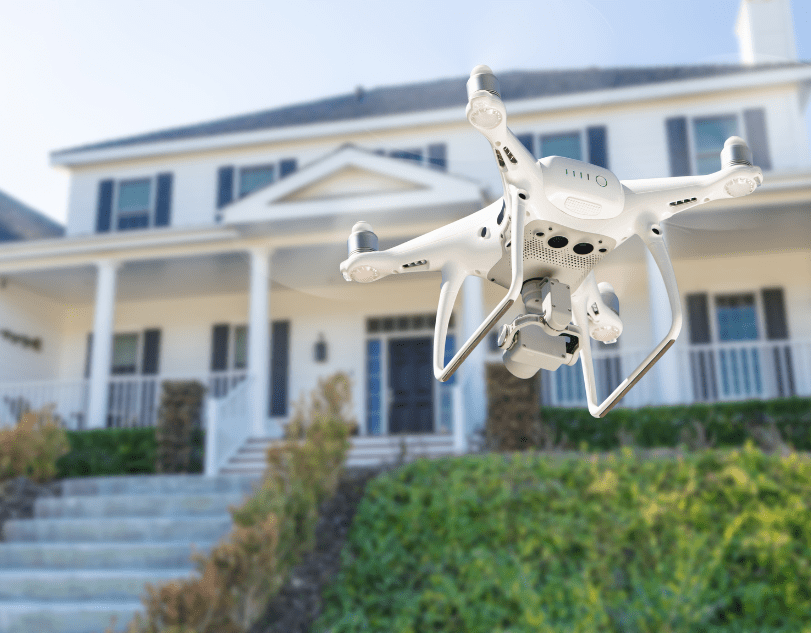
How Tech Is Quietly Rewriting Real Estate Photography
A few weeks ago, my 11-year-old son shocked me.
He asked if he could come with me on a real estate property visit.
This is a kid who cares deeply about Minecraft, 3D printing, and his Prime bottle collection — not occupancy rates or rent comps. So I asked him why.
He didn’t hesitate.
“I want to take drone shots of your buildings!”
We had just gotten him a DJI Neo, a small, beginner-friendly $199 drone. It shoots crisp photos, stable videos, and goes a couple hundred feet in the air without drama. It’s practically designed for kids… and yet the images look good enough that you could slip them into an MLS listing.
I wasn’t selling the property, and if I were, I’d hire a professional.
But the moment stayed with me.
Drone photography has become so universal that even kids recognize it as “real estate content.”
That sparked a bigger thought: real estate photography has quietly transformed — and the driving force is technology.
Not just drones.
But AI-enhanced editing.
Virtual staging.
3D digital twins.
Cloud rendering.
If you’re someone in tech — engineering, product, data, design — you’ll recognize how quickly these innovations have matured.
Here’s the updated landscape.
AI Editing: A Decade of Progress in 12 Months
Ten years ago, editing real estate photos meant long hours in Lightroom and Photoshop. Today, AI tools do most of the heavy lifting.
Platforms like AgentUp (formerly PhotoUp), Imagen AI, and Luminar Neo automate sky replacement, relighting, object removal, and HDR blending. Adobe’s own Generative Fill and AI Denoise in Photoshop and Lightroom have taken what used to be minutes or hours and reduced it to seconds.
High-volume real estate photographers now rely on these tools because they create consistent, predictable results — something large brokerages care about.
PhotoUp’s internal data shows that AI-assisted edits have cut turnaround times by nearly 70%, letting agencies publish listings faster.
Even tools like ON1 Photo RAW and Scouty AI now handle batch HDR, perspective correction (a lifesaver for interior shots), virtual staging, and bulk color consistency. What used to require a graphic designer is now a commodity, available to anyone with a laptop.
In short:
AI has turned real estate editing into a scalable, almost push-button process.
Drones: The Sky Has Become a Standard Camera Angle
Five years ago, aerial shots were a premium add-on. Today, they’re everywhere.
Open Zillow.
Open Redfin.
Open Realtor.com.
Almost every other listing includes drone shots.
And it makes sense. Aerial photography shows things ground photos cannot:
- neighborhood layout
- parking and access
- roofline condition
- proximity to amenities
- landscaping and lot shape
Real estate teams now rely on drones from DJI — still the undisputed leader.
From your son’s DJI Neo all the way to the Mini 4 Pro or Air 3, DJI dominates the real-estate drone ecosystem.
Service providers like HomeJab, Birdseye Aerial Drones, DroneBase, and SoldByAir have made aerial imagery accessible nationwide. The FAA made things easier too: the Part 107 certification, introduced in 2016 and refined since, opened the door for thousands of licensed operators across the U.S.
There’s a reason this shift happened so fast.
According to SoldByAir’s analysis of MLS listings, aerial photos drive 4–6× more online engagement than standard images.
An MLS study cited by multiple brokers found that listings with aerial shots sold up to 68% faster than those without.
Whether you’re selling a suburban home or presenting a multifamily property to investors, aerials have become part of the visual language of real estate.
3D Virtual Tours: The New “First Showing”
While drones transformed the outside, 3D tours transformed the inside.
Matterport leads the industry with its Pro2 and Pro3 cameras as well as its smartphone scanning tools. The result is a fully navigable digital version of a property — what the industry now calls a “digital twin.”
Other vendors such as Diakrit, Imagtor, and Transparent House provide variations of virtual tours, floor plans, and high-end CGI.
These aren’t just fancy add-ons anymore — they’ve changed buyer behavior.
At Old Money Capital’s Modesto properties, our property manager won’t even schedule an in-person showing until a prospective tenant submits an application. It sounds bold, but it works — because the 3D tours do the heavy lifting. The tours give renters such a clear sense of the space that most people know right away whether the unit fits their life. By the time they click “Apply,” they’ve already walked through the home virtually, inspected every corner, and made a confident decision.
Matterport’s 2023 and 2024 reports show that listings with 3D tours attract up to three times more engagement than standard photo-only listings.
Zillow’s Consumer Housing Trends Report highlights that nearly 60% of buyers prefer or expect 3D tours, and almost half skip listings that don’t have them.
Redfin data shows that buyers use virtual tours to “pre-qualify” properties, reducing wasted showings by as much as 50%.
For busy professionals — especially in tech — this is a gift.
You can effectively “walk through” 10 properties in 15 minutes.
The Big Picture: Real Estate Has Become Visual Tech
All of these innovations — AI editing, drones, 3D tours — have one thing in common:
They’re powered by the same technological forces reshaping everything else: AI, computer vision, cloud processing, and consumer-grade hardware.
Real estate hasn’t always been the fastest industry to adopt technology, but visual storytelling is one area where the leap has been dramatic.
The winners will be:
- Agents who embrace these tools
- Buyers who now begin their search online
- Photographers who combine craft with automation
For me, the shift became obvious only when my son grabbed his DJI Neo and said, “Let’s get drone shots.”
Sometimes the future doesn’t walk through the front door.
Sometimes it flies right over it.

Leave a Reply